
by Rick O'Connor | Apr 8, 2016
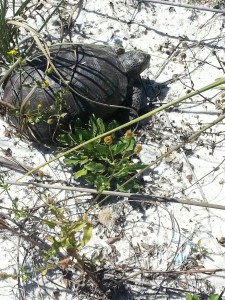
This gopher tortoise was found in the dune fields on a barrier island – an area where they were once found.
Photo: DJ Zemenick
The state of Florida has designated Sunday April 10 as “Gopher Tortoise Day”. The objective is to bring awareness to this declining species and, hopefully, an interest in protecting it.
During his travels across the southeast in the late 18th century, William Bartram mentioned this creature several times. As he walked through miles of open longleaf pine he would climb sand hills where he often encountered the tortoise. These turtles do like high dry sandy habitats. Here they dig their famous burrows into the earth.
These burrows can extend almost 10 feet vertically below the surface but, being excavated at an angle, can extend 20 feet in length. There is only one entrance and the tortoise works hard to maintain it. Field biologists have been able to identify over 370 species of upland creatures that utilize these burrows as refuge either for short or long periods of time. These include the declining diamondback rattlesnakes, gopher frogs, and the endangered indigo snakes, but most are insects and small mammals. Because of the importance of the burrows to these species, gopher tortoises are listed as keystone species – meaning their decline will trigger the decline of the others and can upset the balance of the ecosystem. Gopher burrows can be distinguished from mammal burrows in that they are domed across the top but flat along the bottom, as opposed to being oval. The width of the burrow is close to the length of the tortoise. When danger is encountered the tortoise will turn sideways – effectively blocking the entire entrance. Though there are cases of multiple tortoises in one, the general rule is one tortoise per burrow.
Tortoises are herbivores, feeding on a variety of young herbaceous shoots, and fruit when they can get find them. Fire is important to the longleaf system and it is important to the gophers as well. Fires encourage new young shoots to sprout. If an area does not receive sufficient fire, and the ground vegetation allowed grow larger with tougher leaves, the tortoise will abandon their burrow and seek more suitable habitat – which, especially in Florida – is becoming harder and harder to find. They typically breed in the fall and will lay their 5-10 eggs in the loose sand near the entrance of the burrow in spring. In August the hatchlings emerge and may hide beneath leaf litter, but will quickly begin their own burrows.
This tortoise is only found in the southeast of the United States and it is in decline across the region. They are currently listed as threatened in Florida but are federally protected in Louisiana, Mississippi, and western Alabama. They are found across our state as far south as the Everglades. There are several reasons why their numbers have declined. Human consumption was common in the early parts of the 20th century, and still is in some locations – though illegal. Some would, at times, pour gasoline down the burrow to capture rattlesnakes – this of course did not fare well for the tortoise. A big problem is the loss of suitable habitat. Much of upland systems require periodic fires to maintain the reproductive cycle of community members. The suppression of fire has caused the decline of many species in our state including gopher tortoises. These under maintained forest have forced tortoises to roadsides, power line fields, airports, and pastures. In each case they have encountered humans with cars, lawn mowers, and heavy equipment. Keep in mind also that our growing population is forcing us to clear much of these upland habitats for developments where clearing has caused the burial (entombment) of many burrows.
This is a unique turtle to our region and honestly, is a pleasure to see. We hope you will take the time to learn more about them by visiting FWC’s Gopher Tortoise Day website, enjoy watching them if they live near you, and help us conserve this species for future generations.
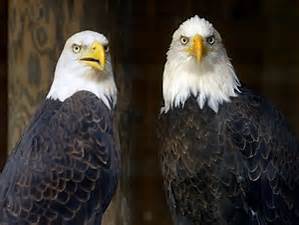
by Rick O'Connor | Mar 25, 2016

The majestic bald eagle. Their numbers are increasing along the Florida Panhandle.
Photo: Pensacola New Journal
ARTICLE BY DOROTHY KAUFMANN – Wildlife Sanctuary of Northwest Florida
Orphaned bald eagles are being fostered by two non-releasable adult eagles at the Wildlife Sanctuary of Northwest Florida.
The amazing story of these eagles began on St. George Island when concerned neighbors, Kevin and Chantel Burdett, Lauren Levi, and Kenny Piotrowski, rescued two fallen chicks after their nest tree came down in a storm. Emergency care began with Chris Beatty, Florida wildlife Mammal Association in Crawfordville, after being transported by Apalachicola National Estuarine Research Reserve staff. One eaglet sustained injuries from the fall while the other remained uninjured. Plans were immediately underway to rebuild a nest and return the uninjured chick. The following day both eaglets were stable enough to be transferred to the Wildlife Sanctuary in Pensacola for continued care and treatment.
A team continued working to reunite the healthy eaglet with its parents but first a replacement nest had to be built. Next, a secure tree nearby the original site had to be found for the new nest. Finally, get the nest and chick to the top of the tree. Just how many people does it take? Well, this time it was three state agencies, two wildlife rehabilitators, one veterinarian, Duke Energy – the largest electric utility in the country, with their bucket truck, one EagleWatch Program professional, several concerned citizens, and one federal agency to attempt to reunite this eaglet. “It wasn’t long before we had our ducks (eaglets) in a row for a coordinated effort to try sand reunite parents with chicks”, said Erik Lovestrand, director of the UF/IFAS Franklin County Extension Office. “Duke Energy is proud to have been part of the effort to find these baby eagles a new home”, said David Collins – government and community relations manager with Duke Energy.
The weather that had been the reason for the home nest to fall continued to dictate the little eaglet’s destiny. The reunion day turned out to be very cold and rainy for everyone. Efforts to reunite the eaglet were unsuccessful. Foster parents… yes… that’s plan B… the eaglets are both being raised by experienced “eagle parents” to have the best chance at a later release back to the wild. These adults are permanently injured bald eagles and residents of the Wildlife Sanctuary of NWFL. The injured eaglet is currently recovering at WSNF from a fractured leg and wing. Both eaglets are off display to the public due to the need to keep them wild. Video cameras at the Sanctuary allow viewing of the eagle family without any disturbance.
“Though I know we are all very disappointed that the parents did not return, we all pulled together to try to help this young eaglet which was a very awesome experience. We were so honored to be amongst such a wonderful and caring group of people”, commented Chris Beatty.
How amazing that what seemed to be a day about a single family of eagles… is actually an ongoing lesson in caring, awareness, and community.
SPECIAL NOTES:
Attending veterinarian Dr. Tommy Knight of Westside Animal Hospital
The new eagle nest site was selected by Erik Lovestrand (UF/IFAS Extension), Lauren Levi (Apalachicola NERR), and Lynda White (AEW).
Supplies for the platform were provided by Jenna Harper (Apalachicola NERR) and constructed by Kenny Piotrowski (local carpenter).
The platform was secured and eaglet placed within by Duke Energy.
Neighbor Kevin Burdett also played an important role in encouraging the adult eagles to remain in the nesting area – he played audio calls of the eaglets.
Others attending the attempted eagle reunion monitored the activity and remained in an inconspicuous location awaiting the adult eagles return.
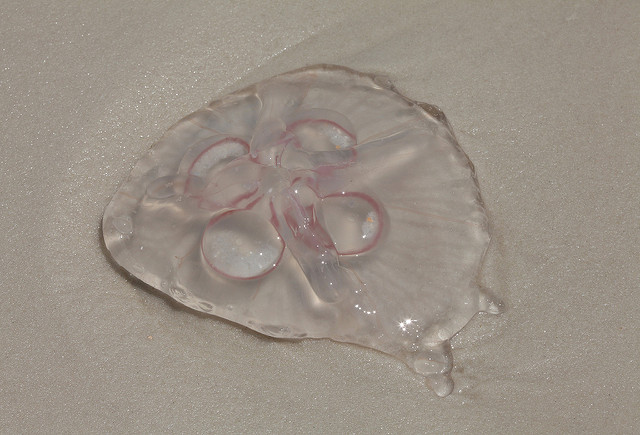
by Erik Lovestrand | Mar 25, 2016
Summertime and swimming at the beach just go together naturally in Florida with our state’s more than 1,000 miles of coastline. Many fond memories are created along these salty margins and the Panhandle region of the state has some of the top-rated beaches in the world. It is a great place to experience a relaxing, cool dip in the Gulf of Mexico on a balmy summer day. One thing to be aware of though is the possibility of an encounter with one of the Gulf’s “stinging” inhabitants and what to do if this occurs.
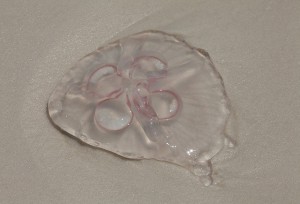
The Moon Jelly is a Common Inhabitant Along Panhandle Shores. Photo courtesy Florida Sea Grant
There are actually several different organisms that have the capability to sting. This is primarily their mechanism for capturing food but it may also serve to deter predators. Most belong to a group of organisms called “Cnidarians,” which includes the jellyfish. Most jellyfish are harmless to us and are important food sources for many other marine creatures, including some sea turtles, fish and even other jellies! Some species are even dried, shredded and eaten by humans. However, there are several types of jellyfish that will inflict a sting when brushed against and some that are actually a serious hazard. Keep in mind that people also react differently to most venoms, exhibiting varying degrees of sensitivity. The most dangerous types include some of the box jellyfish species (visit HERE for general map of worldwide jellyfish fatalities), and the blue-colored Portuguese man-o-war, which is sometimes common on our shores after sustained southerly winds during summer. A few of our locally common species that cause pain but of a generally less-severe nature include the moon jelly, sea nettle, and cannonball jellyfish. We even have some species of hydroids that look very much like a bushy brown or red algae. They are usually attached to the bottom substrate but when pieces break off and drift into the surf they can provide a painful encounter.
If you are stung there are a couple of things you can do to help and a couple of things you should not do. First, move away from the location by getting out of the water so you don’t encounter more tentacles. Carefully remove any visible tentacle pieces but not with your fingers. You should also change out of swimwear that may have trapped pieces of tentacles or tiny larval jellyfish against the skin. Do not rinse the area with fresh water as this causes the remaining stinging cells to fire their venomous harpoons. If symptoms go beyond a painful sting to having difficulty breathing or chest pain you should immediately call the Poison Information Center Network at 1-800-222-1222 or call 911.
Another thing to watch for in areas where public beaches display the beach warning flag system is a purple flag. This flag color at the beach indicates dangerous marine life and quite often it is flown when jellyfish numbers are at high levels. All of this is being written, not to scare you away from our beaches, but to help you enjoy our beautiful coastline with a little better understanding of what is out there and what to do if you happen to have a brush with a jellyfish. The vast majority of encounters are a minor irritation in an otherwise pleasant experience.
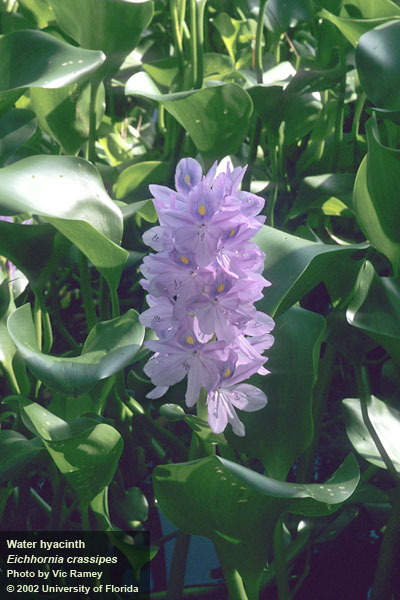
by Libbie Johnson | Feb 24, 2016
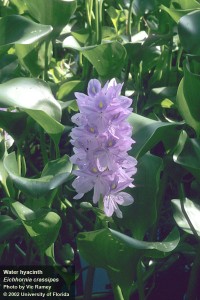 Libbie Johnson
Libbie Johnson
UF IFAS Escambia County Extension
Northwest Florida can be a pond owner’s paradise. There is usually enough rainfall to keep ponds filled, catfish, bass, and brim are well adapted to the environmental conditions, and there is a long season to catch fish.
One of the biggest problems pond owners face is the constant struggle with pond vegetation. Some pond vegetation is good. It provides a cover for young fish, helps stabilize the shoreline or bank, and some vegetative species are attractive wildlife.
However some species are highly invasive and can completely overtake a pond. One such species is water hyacinth (Eichhornia crassipes).
The water hyacinth is a floating plant, which if left unchecked and allowed to grow to its maximum potential, can weigh up to 200 tons per acre of water. In rivers, it can choke out other vegetation and make navigation difficult to impossible.
Water hyacinth, as an ornamental plant, is a wolf in sheep’s clothing. The plants intertwined and form huge floating mats which can root on muddy surfaces, as seen in the photo below.
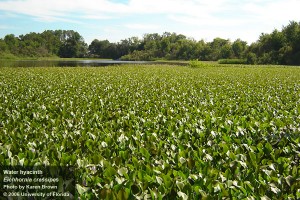
The plant will be several inches tall, has showy lavender flowers, with rounded, shiny, smooth leaves. These leaves are attached to spongy stalks that help keep the plants afloat. The prolific roots are dark and feathery.
In Northwest Florida this pest commonly dies back in the winter. Unfortunately it is able to regrow when the weather and water warm.
Water hyacinth is not a native species. It is believed to have been introduced into the U.S. in 1884 at an exposition in New Orleans. Within 70 years of reaching Florida, the plant covered 126,000 acres of waterways (Schmitz et al. 1993).
Water hyacinth is on the FL DACS Prohibited Aquatic Plant List – 5B-64.011. According to Florida Statute 369.25, “No person shall import, transport, cultivate, collect, sell, or possess any noxious aquatic plant listed on the prohibited aquatic plant list established by the department without a permit issued by the department.”
To control a small infestation, the plants can be gathered from the surface, brought to the shore, left to dry and then disposed of in the garbage. There are biological control options—water hyacinth weevils will be useful in keeping the plant populations down.
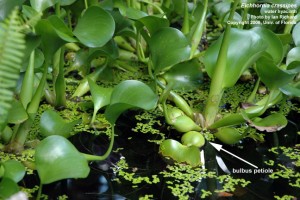
The spongy petiole helps keeps the plant afloat.
Finally, chemical herbicide options may be the best alternative. University of Florida Aquatic Vegetation Specialist, Dr. Langeland, wrote Efficacy of Herbicide Active Ingredients Against Aquatic Weeds, a good publication that will help you to determine which herbicide will work best for different weeds.
NOTE: The middle of the summer is generally not the ideal time for applying herbicide on pond vegetation. For more information on weed control in Florida ponds, please see Weed Control in Florida Ponds. If you have any questions about identifying a pond weed, contact your local county Extension agent.
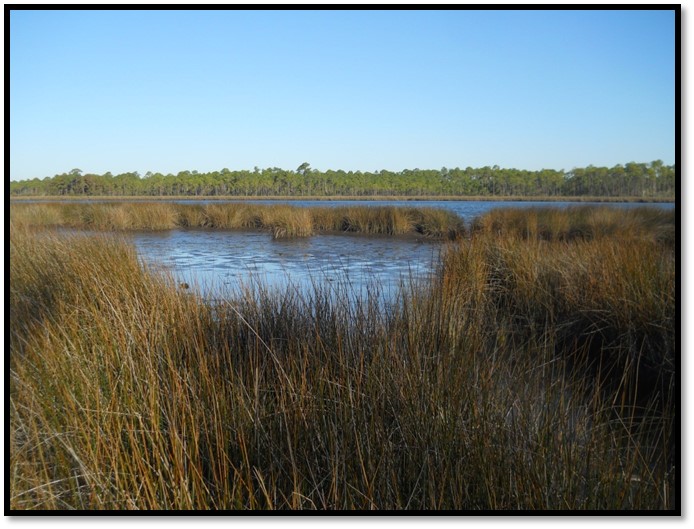
by Carrie Stevenson | Feb 5, 2016
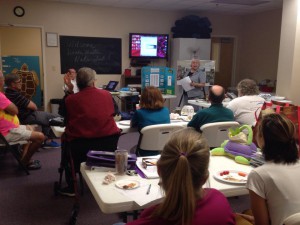
On “project day” students share their knowledge with the class. Photo credit: Carrie Stevenson
The Florida Master Naturalist Program is a 40-hour experiential learning course offered by UF IFAS Extension. While we spend time in class with presentations, by far everyone’s favorite aspects of the course are field trips and “project day.” As part of the course, each participant produces an educational tool—a display, presentation, skit, or lesson—that delves deeper into a topic of interest. The students and instructors are able to use these tools again and again to teach others.
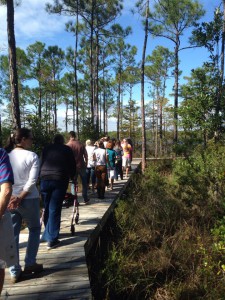
Master Naturalist students walk “The Way” boardwalk in Perdido Key. Photo credit: Carrie Stevenson
One example of a multi-year student project is “The Way” nature trail, located at Perdido Bay United Methodist Church. Master Naturalist Jerry Patee worked with volunteers from his church and community to design and permit a boardwalk and nature trail leading to Bayou Garcon. The unique trail is less than a mile, but traverses upland, freshwater wetland, and coastal habitats, making it a perfect ecological teaching tool. The trail is open to the public and maintained as a place of quiet contemplation. The project is ongoing, with educational signage planned, but it is an excellent new resource for the community.
“The Way” is just one of many positive contributions made by Master Naturalist students over the years. To enroll in a Florida Master Naturalist course near you, visit the FMNP page or talk with an instructor at your local county Extension office.

by Judy Biss | Dec 4, 2015

To be successful hunters of the night, owls have some truly amazing physiological adaptations. This closeup of a barn owl shows a few in the large eyes and dish shaped face that help perfect its hearing and sight. Compliments UF/IFAS File Photo
Some of my favorite creatures are owls, and as you can see by the quotes below, owls have captivated humans across the ages.
And thorns shall come up in her palaces, nettles and brambles in the fortresses thereof: and it shall be an habitation of dragons, and a court for owls.
Isaiah 34:13
“Owl,” said Rabbit shortly, “you and I have brains. The others have fluff. If there is any thinking to be done in this Forest–and when I say thinking I mean thinking–you and I must do it.”
― A.A. Milne, The House at Pooh Corner
“I think I’m a tiny bit like Harry ‘cos I’d like to have an owl. Yeah, that’s the tiny bit, actually.”
― Daniel Radcliffe (Actor who portrays Harry Potter)
According to the Florida Audubon Society, Florida is the year-round home to six (6) species of owls and four (4*) occasional visitors such as the striking Snowy Owl. These owls are listed in the Audubon of Florida Checklist of Florida Birds and are the:
Barn Owl
Barred Owl
Burrowing Owl
Eastern Screech-Owl
Great Horned Owl
Short-eared Owl
(*exceedingly rare)
Flammulated Owl *
Long-eared Owl *
Northern Saw-whet Owl *
Snowy Owl *
Each of the species links above will take you to the Cornell University CornellLab of Ornithology providing information about these owls including an audio clip of their unique calls. It’s an informative site, so be sure to click on your favorite owl for more information and to listen to their calls.
Owls are mainly nocturnal hunters, which means they are most actively feeding at night. Depending on the species, their diet is quite varied and includes, insects, lizards, a variety of small rodents, birds, and even crayfish. Nesting pairs of owls and their voracious owlets can consume thousands of small rodents in a year. Because they eat a variety of prey and are significant rodent predators, owls are welcome residents on most farms and homesteads.
To be successful hunters of the night, owls have some truly amazing physiological adaptations, such as the ability to rotate their heads 270 degrees, ears that are offset on the sides of their head in order to pinpoint location of prey, the ability to control feathers on their dish shaped face to direct sounds into their ears, and comb like structures on their feathers to silence them in flight. The following details about these and other adaptations are taken from the Cornell University CornellLab of Ornithology – the Owl Page, and Blogs at Cornell University-Anatomy of Owls.
Sight
Owls’ large forward facing eyes give them the best stereoscopic vision of all birds, which is vital for judging distances. The shape of their eyes, their unusually high number of light-sensitive cells, their large pupils, and a reflective layer behind the retina (called the “tapetum lucidum”) give them excellent nocturnal vision useful when hunting at night or navigating dark forests. The shape of their eyes limits their ability to move them in the eye sockets, but their necks can turn up to 270 degrees.
Hearing
Their ability to locate prey by sound alone is the most accurate of any animal that has ever been tested. These owls can catch mice in complete darkness in the lab, or prey hidden by vegetation or snow out in the real world. Their ears are placed unevenly on their head and point in slightly different directions, giving the ability to hear where a sound is coming from without moving their heads. Owls can also funnel sound toward their ears by manipulating different types of feathers around the ears and face.
Silent Flight
On both the primary and secondary feathers, there are comb-like structures at the edge of the feather that are responsible for muffling the sound of the air going over the wing – this essentially makes an owl silent when they fly. Also, an owl’s feathers can separate from each other on the same wing; therefore, the air flows over each of the individual feathers and their comb-like structures, which maximizes how silently an owl flies.

BELLE GLADE—University of Florida graduate researcher Cosandra Hochreiter checks on a barn owl nesting site on the grounds of UF’s Everglades Research and Education Center. The five owlets in this corner were among several babies and their parents nesting in this abandoned barn at the research center. Researchers are trying to boost the population of barn owls in the Everglades Agricultural Area because they are a natural form of rodent control. Rodents can cause up to $30 million damage per year to sugar cane and vegetable crops, and a nesting pair of barn owls can eat almost 3,000 rodents over the course of a year. Compliments UF/IFAS File Photo
Owl Pellets
Owls swallow their prey whole or in large pieces, but they cannot digest fur, teeth, bones, or feathers. Like other birds, owls have two chambers in their stomachs. In the first chamber, all the digestible parts of an owl’s meal are liquefied. Then the meal passes into the second chamber, the muscular stomach or gizzard, which grinds down hard structures and squeezes the digestible food into the intestines. The remaining, indigestible fur, bones, and teeth are compacted into a pellet which the owl spits out. Owls typically cast one pellet per day, often from the same roosting spot, so you may find large numbers of owl pellets on the ground in a single place.
Nesting
Owls will typically nest in cavities of mature trees, or will use the nests of other birds or even squirrels. Burrowing Owls nest in the ground, and although it can dig its own burrow, it often uses holes already created by skunks, armadillos, or tortoises. Some owls will use artificial nest boxes, and building plans for the Great horned, Barred, and Barn owls are found here at this website: Cornell University CornellLab of Ornithology – the Owl Page
So, the next time you are enchanted by the familiar sound of our common Barred Owl, or if you happen to find a few owl pellets below a tree, think also of the many amazing attributes of Florida’s owls, our stealthy nocturnal predator.
For more information on this topic please see the following resources used for this article:
Barn Owl (Tyto alba)
Barred Owl (Strix varia)
Helping Cavity-nesters in Florida
Cornell University CornellLab of Ornithology – the Owl Page
Florida Audubon Society
North American Owls: Biology and Natural History














